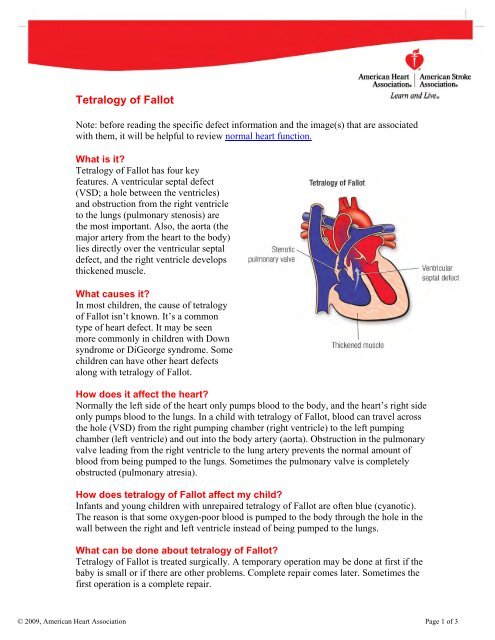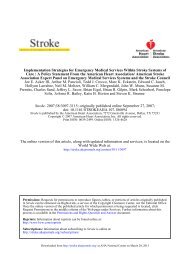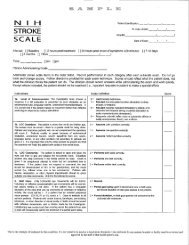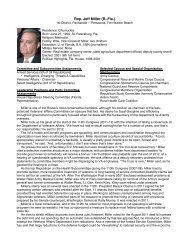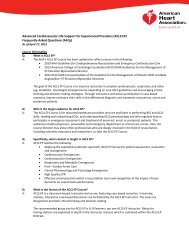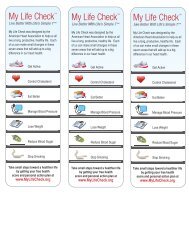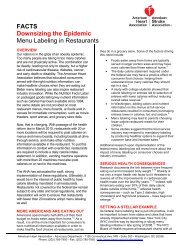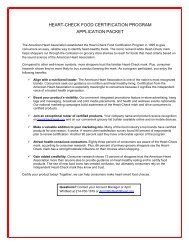Tetralogy of Fallot - American Heart Association
Tetralogy of Fallot - American Heart Association
Tetralogy of Fallot - American Heart Association
You also want an ePaper? Increase the reach of your titles
YUMPU automatically turns print PDFs into web optimized ePapers that Google loves.
<strong>Tetralogy</strong> <strong>of</strong> <strong>Fallot</strong><br />
Note: before reading the specific defect information and the image(s) that are associated<br />
with them, it will be helpful to review normal heart function.<br />
What is it?<br />
<strong>Tetralogy</strong> <strong>of</strong> <strong>Fallot</strong> has four key<br />
features. A ventricular septal defect<br />
(VSD; a hole between the ventricles)<br />
and obstruction from the right ventricle<br />
to the lungs (pulmonary stenosis) are<br />
the most important. Also, the aorta (the<br />
major artery from the heart to the body)<br />
lies directly over the ventricular septal<br />
defect, and the right ventricle develops<br />
thickened muscle.<br />
What causes it?<br />
In most children, the cause <strong>of</strong> tetralogy<br />
<strong>of</strong> <strong>Fallot</strong> isn’t known. It’s a common<br />
type <strong>of</strong> heart defect. It may be seen<br />
more commonly in children with Down<br />
syndrome or DiGeorge syndrome. Some<br />
children can have other heart defects<br />
along with tetralogy <strong>of</strong> <strong>Fallot</strong>.<br />
How does it affect the heart?<br />
Normally the left side <strong>of</strong> the heart only pumps blood to the body, and the heart’s right side<br />
only pumps blood to the lungs. In a child with tetralogy <strong>of</strong> <strong>Fallot</strong>, blood can travel across<br />
the hole (VSD) from the right pumping chamber (right ventricle) to the left pumping<br />
chamber (left ventricle) and out into the body artery (aorta). Obstruction in the pulmonary<br />
valve leading from the right ventricle to the lung artery prevents the normal amount <strong>of</strong><br />
blood from being pumped to the lungs. Sometimes the pulmonary valve is completely<br />
obstructed (pulmonary atresia).<br />
How does tetralogy <strong>of</strong> <strong>Fallot</strong> affect my child?<br />
Infants and young children with unrepaired tetralogy <strong>of</strong> <strong>Fallot</strong> are <strong>of</strong>ten blue (cyanotic).<br />
The reason is that some oxygen-poor blood is pumped to the body through the hole in the<br />
wall between the right and left ventricle instead <strong>of</strong> being pumped to the lungs.<br />
What can be done about tetralogy <strong>of</strong> <strong>Fallot</strong>?<br />
<strong>Tetralogy</strong> <strong>of</strong> <strong>Fallot</strong> is treated surgically. A temporary operation may be done at first if the<br />
baby is small or if there are other problems. Complete repair comes later. Sometimes the<br />
first operation is a complete repair.<br />
© 2009, <strong>American</strong> <strong>Heart</strong> <strong>Association</strong> Page 1 <strong>of</strong> 3
<strong>Tetralogy</strong> <strong>of</strong> <strong>Fallot</strong><br />
Temporary Operation<br />
In some infants, a shunt operation may be done first to<br />
provide adequate blood flow to the lungs. This is not openheart<br />
surgery and doesn’t fix the inside <strong>of</strong> the heart. The<br />
shunt is usually a small tube <strong>of</strong> synthetic material sewn<br />
between a body artery (or the aorta) and the pulmonary<br />
artery. The shunt is closed when a complete repair is done<br />
later.<br />
Complete Repair<br />
Complete repair tends to be done early in life. The<br />
surgeon closes the ventricular septal defect with a patch<br />
and opens the right ventricular outflow tract by removing<br />
some thickened muscle below the pulmonary valve,<br />
repairing or removing the obstructed pulmonary valve<br />
and, if needed, enlarging the branch pulmonary arteries<br />
that go to each lung.<br />
Sometimes a tube is placed between the right ventricle<br />
and the pulmonary artery. This is sometimes called a<br />
Rastelli repair. It’s similar to the type <strong>of</strong> repair used for<br />
some other heart defects.<br />
Will my child’s activities be limited?<br />
Your child may need to limit physical activity, particularly for competitive sports, if there<br />
is leftover obstruction or leak in the pulmonary valve, which is common after repair.<br />
Children with decreased heart function or rhythm disturbances may need to limit their<br />
activity more.<br />
If the tetralogy has been repaired with surgery, and there’s no obstruction or leak in the<br />
pulmonary valve, your child may be able to participate in normal activities without much<br />
increased risk.<br />
Your child’s pediatric cardiologist will help decide if your child needs limits on physical<br />
activity.<br />
© 2009, <strong>American</strong> <strong>Heart</strong> <strong>Association</strong> Page 2 <strong>of</strong> 3
<strong>Tetralogy</strong> <strong>of</strong> <strong>Fallot</strong><br />
What will my child need in the future?<br />
If your child has had tetralogy <strong>of</strong> <strong>Fallot</strong> repaired, he or she will need regular follow-up with<br />
a pediatric cardiologist. As an adult, your child will need lifelong regular follow-up with a<br />
cardiologist who’s had special training in congenital heart defects.<br />
Some long-term problems can include leftover or worsening obstruction between the right<br />
pumping chamber and the lung arteries. Children with repaired tetralogy <strong>of</strong> <strong>Fallot</strong> have a<br />
higher risk <strong>of</strong> heart rhythm disturbances called arrhythmias. Sometimes these may cause<br />
dizziness or fainting.<br />
Generally, the long-term outlook is good, but some children may need medicines, heart<br />
catheterization or even more surgery.<br />
What about preventing endocarditis?<br />
Children with tetralogy <strong>of</strong> <strong>Fallot</strong> are at increased risk for endocarditis. Some children,<br />
including those have had a valve replacement, still have a shunt or have leaks around<br />
surgical patches, and need to take antibiotics before certain dental procedures to help<br />
prevent endocarditis. See the section on endocarditis for more information.<br />
© 2009, <strong>American</strong> <strong>Heart</strong> <strong>Association</strong> Page 3 <strong>of</strong> 3


